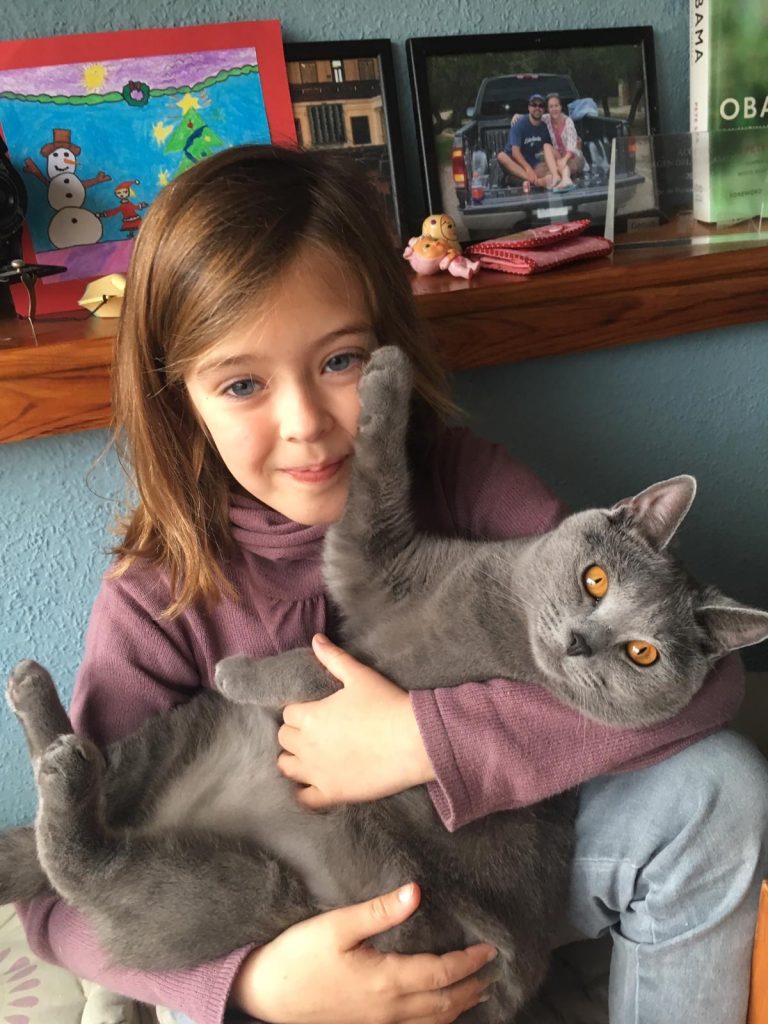We may never know whether there is any truth to the legend of Chartreux cats having been raised by monks. However, these cats do have all the qualities to be ideal companions for the monastic life, as well as for our modern lifestyles. One of the calmest of the shorthair breeds, the Chartreux is particularly easy to live with; a peaceful, quiet and devoted companion.

Chartreux adapt well to most environments and situations. They get along with other animals, and their gentle, tolerant nature makes them good pets for families with children.
Most Chartreux have a tiny voice that they use only rarely. Some are mute, giving rise to the legend that these cats “took the vow of silence with the monks.” Yet they are expert communicators, using murmurs and chirps, expressive eyes and subtle body language.
They enjoy close, affectionate relationships with their owners, yet they are polite and not demanding. Your Chartreux might use a gentle paw touch as a request to get into your lap, or ask for play time by bringing you a toy.
Chartreux are creatures of habit, and develop rituals and routines that they enjoy with their owners, frequently following their owners from room to room. Known for their dog-like behavior, many Chartreux will fetch, and most will respond to their names. Some Chartreux and their owners also enjoy learning tricks with clicker training.
Health and Life Span
The Chartreux is generally a healthy breed. Average life span is about 15 years; with luck and good care, some Chartreux live to 18 or 19.
Patellar luxation (loose kneecaps that can spontaneously slip out of the groove) can be an inherited health issue for Chartreux. Many years ago, this was a significant problem in some bloodlines. Through careful selection, breeders have gradually reduced the incidence of patellar luxation, and the majority of Chartreux today have healthy knees. Chartreux with slightly loose knees are not likely to have mobility issues during their lifetime, but should not be used for breeding.
Many Chartreux breeders periodically screen their breeding cats for hypertrophic cardiomyopathy (HCM). HCM is a serious, life-threatening condition that can occur in any breed, as well as in non-pedigreed cats, and can have various causes. Some Chartreux are known to have developed HCM, but we do not know for certain whether or not this is an inherited health condition in our breed. It is recommended for breeders to screen breeding cats and communicate their findings to other breeders, so that we can prevent HCM from becoming a bigger problem.
Grooming and Care
Chartreux have a heavy double coat, with water-repellent guard hairs, and a dense undercoat made up of fine-textured wooly hairs. It’s a good idea to comb dead hairs out of the coat occasionally, in order to reduce shedding and hairballs. A wide-spaced metal comb can work well for gently removing dead hairs without stripping out too much of the wooly undercoat. Because the undercoat sheds seasonally, during shedding season you may need to comb out the coat more frequently.
Weight gain can be a problem for some mature Chartreux. Although this is naturally a massive breed, a Chartreux should have a solid and muscular body feel. Keep an eye on your cat’s weight, and ask your cat’s breeder for diet recommendations if your cat has trouble maintaining a healthy body condition.
Dental health is important for all cats. Some Chartreux have healthy teeth and gums throughout life, with minimal care required. Others have more of a tendency towards gingivitis, and require occasional dental cleanings at the vet, especially as they get older. Many cats can learn to tolerate having their teeth brushed at home, which can help reduce or even eliminate the need for teeth cleaning in older cats.
Naming Tradition
CFA Chartreux breeders follow the French naming tradition. All kittens born in a given year are named beginning with a specific letter of the alphabet. The letters rotate in a 20 year cycle, omitting the letters K, Q, W, X, Y and Z. For example, Chartreux kittens born in 2020 have names starting with “R” such as Renoir or Romeo.
Acquiring a Chartreux
For references to CFA breeders, the official place to start is CFA’s breeder search, although not all breeders are listed there. You can also contact our Breed Council Secretary for help finding Chartreux breeders.
If you are looking for a kitten, be prepared for the search to take some time. Most Chartreux breeders have just a few breeding cats, and do not have kittens available at all times. Some breeders may put you on a waiting list, or suggest that you check back later to see if they have kittens in the future.
Adopting an adult Chartreux can also be a great choice, if you do not have your heart set on a kitten. You can ask breeders if they have any retired adults available. Young adults may have been kept a little longer by the breeder for evaluation, or may have been taken to some shows to earn a title before being made available for placement. Older adults may be ready to retire from their breeding careers and become devoted family pets.
